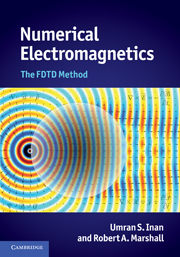Numerical Electromagnetics
Beginning with the development of finite difference equations, and leading to the complete FDTD algorithm, this is a coherent introduction to the FDTD method (the method of choice for modeling Maxwell's equations). It provides students and professional engineers with everything they need to know to begin writing FDTD simulations from scratch and to develop a thorough understanding of the inner workings of commercial FDTD software. Stability, numerical dispersion, sources and boundary conditions are all discussed in detail, as are dispersive and anisotropic materials. A comparative introduction of the finite volume and finite element methods is also provided. All concepts are introduced from first principles, so no prior modeling experience is required, and they are made easier to understand through numerous illustrative examples and the inclusion of both intuitive explanations and mathematical derivations.
- Provides students and engineers with everything they need to know to begin writing FDTD simulations from scratch
- Introduces all concepts from first principles, making it ideal for newcomers with no prior modeling experience
- Includes a number of illustrative examples and both intuitive explanations and mathematical derivations of concepts to aid understanding
Reviews & endorsements
'This book is what has been needed to teach in a systematic fashion the theoretical developments and numerical implementations of one of the most powerful numerical techniques in computational electromagnetic[s] with vast applications in a variety of disciplines. The authors have elegantly and masterfully presented the FDTD method from the Maxwell's equations with sufficient rigor to make the book very reachable by students and practising researchers.' Yahya Rahmat-Samii, Distinguished Professor, University of California, Los Angeles
'FDTD is presently the method of choice for solving most numerical electromagnetics studies. The Inan and Marshall book is a very thorough, yet readable, account of all the details of the method, very valuable for students and professionals alike, with problems included, ready for a course. Even those who use commercial programs would benefit from a better understanding of dispersion, accuracy, media descriptions, basic limitations and so on, all treated in great detail. I am sure it will be a good reference for a number of years. No special background [is] needed since basic material for a good understanding is given, such as electromagnetics, or numerical solution[s] of differential equations. Highly recommended.' Jørgen Bach Andersen, Professor Emeritus, Aalborg University
Product details
March 2011Adobe eBook Reader
9781139005944
0 pages
0kg
100 b/w illus. 3 tables 111 exercises
This ISBN is for an eBook version which is distributed on our behalf by a third party.
Table of Contents
- 1. Introduction
- 2. Review of electromagnetic theory
- 3. Partial differential equations and physical systems
- 4. The FDTD grid and the Yee algorithm
- 5. Numerical stability of finite difference methods
- 6. Numerical dispersion and dissipation
- 7. Introduction of sources
- 8. Absorbing boundary conditions
- 9. The perfectly matched layer
- 10. FDTD modeling in dispersive media
- 11. FDTD modeling in anistropic media
- 12. Some advanced topics
- 13. Unconditionally stable implicit FDTD methods
- 14. Finite-difference frequency domain
- 15. Finite volume and finite element methods.







